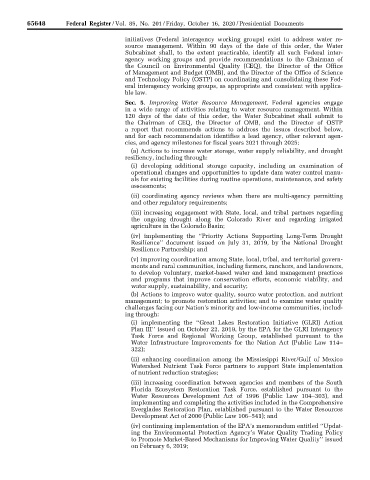Page 1156 - Trump Executive Orders 2017-2021
P. 1156
65648 Federal Register / Vol. 85, No. 201 / Friday, October 16, 2020 / Presidential Documents
initiatives (Federal interagency working groups) exist to address water re-
source management. Within 90 days of the date of this order, the Water
Subcabinet shall, to the extent practicable, identify all such Federal inter-
agency working groups and provide recommendations to the Chairman of
the Council on Environmental Quality (CEQ), the Director of the Office
of Management and Budget (OMB), and the Director of the Office of Science
and Technology Policy (OSTP) on coordinating and consolidating these Fed-
eral interagency working groups, as appropriate and consistent with applica-
ble law.
Sec. 5. Improving Water Resource Management. Federal agencies engage
in a wide range of activities relating to water resource management. Within
120 days of the date of this order, the Water Subcabinet shall submit to
the Chairman of CEQ, the Director of OMB, and the Director of OSTP
a report that recommends actions to address the issues described below,
and for each recommendation identifies a lead agency, other relevant agen-
cies, and agency milestones for fiscal years 2021 through 2025:
(a) Actions to increase water storage, water supply reliability, and drought
resiliency, including through:
(i) developing additional storage capacity, including an examination of
operational changes and opportunities to update dam water control manu-
als for existing facilities during routine operations, maintenance, and safety
assessments;
(ii) coordinating agency reviews when there are multi-agency permitting
and other regulatory requirements;
(iii) increasing engagement with State, local, and tribal partners regarding
the ongoing drought along the Colorado River and regarding irrigated
agriculture in the Colorado Basin;
(iv) implementing the ‘‘Priority Actions Supporting Long-Term Drought
Resilience’’ document issued on July 31, 2019, by the National Drought
Resilience Partnership; and
(v) improving coordination among State, local, tribal, and territorial govern-
ments and rural communities, including farmers, ranchers, and landowners,
to develop voluntary, market-based water and land management practices
and programs that improve conservation efforts, economic viability, and
water supply, sustainability, and security;
(b) Actions to improve water quality, source water protection, and nutrient
management; to promote restoration activities; and to examine water quality
challenges facing our Nation’s minority and low-income communities, includ-
ing through:
(i) implementing the ‘‘Great Lakes Restoration Initiative (GLRI) Action
Plan III’’ issued on October 22, 2019, by the EPA for the GLRI Interagency
Task Force and Regional Working Group, established pursuant to the
Water Infrastructure Improvements for the Nation Act (Public Law 114–
322);
(ii) enhancing coordination among the Mississippi River/Gulf of Mexico
Watershed Nutrient Task Force partners to support State implementation
of nutrient reduction strategies;
(iii) increasing coordination between agencies and members of the South
Florida Ecosystem Restoration Task Force, established pursuant to the
Water Resources Development Act of 1996 (Public Law 104–303), and
implementing and completing the activities included in the Comprehensive
Everglades Restoration Plan, established pursuant to the Water Resources
jbell on DSKJLSW7X2PROD with EXECORD1 VerDate Sep<11>2014 16:05 Oct 15, 2020 Jkt 253001 PO 00000 Frm 00002 Fmt 4790 Sfmt 4790 E:\FR\FM\16OCE1.SGM 16OCE1
Development Act of 2000 (Public Law 106–541); and
(iv) continuing implementation of the EPA’s memorandum entitled ‘‘Updat-
ing the Environmental Protection Agency’s Water Quality Trading Policy
to Promote Market-Based Mechanisms for Improving Water Quality’’ issued
on February 6, 2019;

